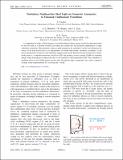Turbulence Nonlinearities Shed Light on Geometric Asymmetry in Tokamak Confinement Transitions
Author(s)
Cziegler, I.; Tynan, G. R.; Hubbard, Amanda E; Hughes Jr, Jerry; Terry, James L
DownloadPhysRevLett.118.105003.pdf (747.3Kb)
PUBLISHER_POLICY
Publisher Policy
Article is made available in accordance with the publisher's policy and may be subject to US copyright law. Please refer to the publisher's site for terms of use.
Terms of use
Metadata
Show full item recordAbstract
A comprehensive study of fully frequency-resolved nonlinear kinetic energy transfer has been performed for the first time in a diverted tokamak, providing new insight into the parametric dependences of edge turbulence transitions. Measurements using gas puff imaging in the turbulent L-mode state illuminate the source of the long known but as yet unexplained “favorable-unfavorable” geometric asymmetry of the power threshold for transition to the turbulence-suppressed H mode. Results from the recently discovered I mode point to a competition between zonal flow (ZF) and geodesic-acoustic modes (GAM) for turbulent energy, while showing new evidence that the I-to-H transition is still dominated by ZFs. The availability of nonlinear drive for the GAM against net heat flux through the edge corresponds very well to empirical scalings found experimentally for accessing the I mode.
Date issued
2017-03Department
Massachusetts Institute of Technology. Plasma Science and Fusion CenterJournal
Physical Review Letters
Publisher
American Physical Society
Citation
Cziegler, I. et al. “Turbulence Nonlinearities Shed Light on Geometric Asymmetry in Tokamak Confinement Transitions.” Physical Review Letters 118.10 (2017): n. pag. © 2017 American Physical Society
Version: Final published version
ISSN
0031-9007
1079-7114